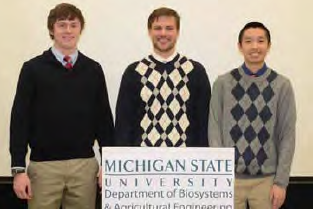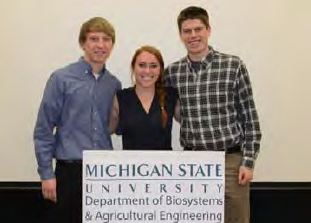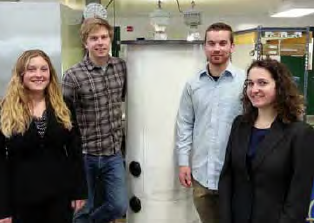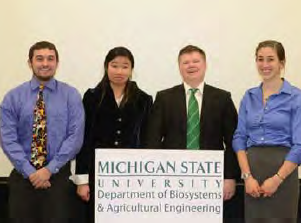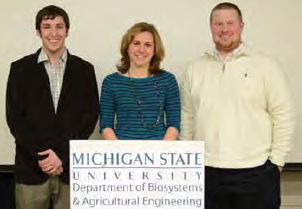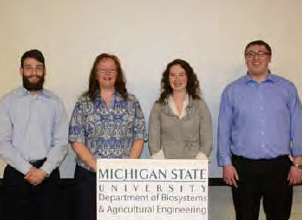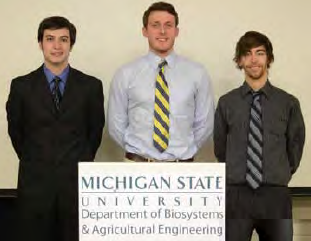Biosystems
Projects
Biosystems Engineering student teams, enrolled in the two-semester biosystems design capstone experience, BE 485/487, develop, evaluate, and select design alternatives in order to solve real-world problems. Projects are diverse, but each reflects systems thinking by integrating interconnected issues affecting the problem, including critical biological constraints. The engineering design process is documented in a detailed technical report. Teams present project designs to engineering faculty and a review panel of professional engineers for evaluation. Each BE 485/487 capstone design team prepares and presents a design solution in report, poster and oral formats to an industry advisory board, faculty, peers and the public that:
- Requires engineering design
- Uses a holistic approach
- Combines biology and engineering
- Interprets data
- Solves a real problem
- Evaluates economic feasibility
For information on sponsoring a project, please contact Dr. Dana Kirk or Dr. Luke Reese.
Pork and Bean Process Optimization
“The Cool Beans” team project is to optimize the Van Camp’s Pork & Beans manufacturing process in order to improve product quality and reduce system losses. Currently a brand leader in the value category, the Van Camp’s lines produce 4 million cases per year.
Client deliverables for this project include a full assessment of the current Pork & Bean process, a statistical analysis of process variation and capability and a process optimization plan. Additionally the team will determine loss reduction solutions through experiments and full economic analysis.
Sponsor – ConAgra
Faculty Advisor – Dr. Kirk Dolan
Industry Evaluators – Cassaundra Edwards & Daniel Holcomb
Cherry Tomato Harvest Production Improvement
The “Biosystems Loves Tomatoes (BLT)” team project is to increase operator productivity during the grape tomato harvest at the Mastronardi Produce facility in Coldwater, MI.
Client deliverables for this project include modified harvest cart prototype with automated drive train and a harvest assist device. Full AutoCAD modification drawings will be provided as well as a full economic analysis including implementation costs and Return on Investment.
Sponsor – Mastronardi Produce
Faculty Advisor – Dr. Dan Guyer
Industry Evaluators – Juanita McCann & Andrew Knowles
Value-Added Fruit Leather Process Line – Ghana
The “Ghana Fruit” team project is to design a fruit leather processing line from raw material to final product, along with initial product formulations.
Client deliverables for this project include a product composition and recipes for both mango and pineapple fruit leathers, a design process flow with equipment specifications and a complete economic analysis with ROI and implementation costs. Team members spent Spring Break in Ghana conducting process research, product testing and presenting to Blue Skies company representatives.
Sponsor – Blue Skies & USAID GFCSI Student Challenge Award
Faculty Advisor – Dr. Brad Marks
Industry Evaluators – Steve Richey & Danielle Habitz
Wastewater Treatment Using Anaerobic Digester
The “AD Strong” team project is to design and develop a novel, efficient pilotscale (.43 m3) up flow and fixed film anaerobic digester to later be connected to an integrated solar-bio-nano-based wastewater utilization system.
As part of a Department of Defense project, client deliverables include a functioning pilot reactor for system performance evaluation and full technical and economic feasibility analysis.
CoSponsor – Technova
Faculty Advisor – Dr. Wei Liao
Industry Evaluators – Michelle Crook & Bryce Feighner
Algal Photoreactor System for Nitrogen Removal
Current closed animal feeding operations generate emissions containing ammonia and other impurities. A wet scrubber system allows for treatment of this polluted air, however, this generates nitrogen-contaminated water.
The “Algaeneers” team project is to design an algal photoreactor system to uptake and balance the nutrient absorption rate in a wet scrubber system. Client deliverables for this project include constructing a functional reactor prototype including CAD drawings, bill of materials, system performance analysis, mass balance and complete economic feasibility analysis.
Sponsor – Quantalux, LLC & USAID GFCSI Student Challenge Award
Faculty Advisor – Dr. Susie Liu & Dr. Jeff Li
Industry Evaluators – Larry Stephens & Valerie Novaes
JBT FoodTech ProMix/ABC-III Viscosity Control
The “Better Batter” team project is to design a viscosity control system for the JBT ProMix/ABC-III automatic batter mixer to reduce the component cost in comparison to the current viscosity pump and pressure transducer control system.
Client deliverables for this project include design concept through lab testing, a complete modification budget with bill of material, pilot verification testing, a correlation curve of apparent viscosity and a measurable rheological property to implement into JBT’s PLC configuration.
Sponsor – JBT FoodTech
Faculty Advisor – Dr. Gail Bornhorst
Industry Evaluators – Mitch Miller & Bob Stacy
Value-Added Fruit Leather Process Line – Ghana
The “Thermal Edge Innovations” team project is to produce briquettes and pellets from torrefied hardwood without binder, and perform optimization and economic comparison studies to determine which has the hygroscopic, friability, and heating value properties that best approach that of coal.
Client deliverables for this project include a briquetting prototype, mass and energy balance data for process, property analysis of torrefied biomass, a supply chain economic model and a techno-economic model.
Sponsor – Heat Transfer International
Faculty Advisor – Dr. Chris Saffron
Industry Evaluators – Dave Prouty & Jeff Mathews
Design of a Fiber-optic Treatment for Infant Jaundice
The “Bullish Biomeds” team project is to design a wearable treatment for infant jaundice using fiber-optic technology in order to reduce cost of treatment, allow for easy deployment in developing countries, and minimize impact to crucial maternal bonding.
Client deliverables include a working prototype using fiber-optic technology that maximizes maternal bonding, and a complete economic analysis for reduced treatment cost and easy deployment to developing countries.
Sponsor – Sygiene
Faculty Advisor – Dr. Tim Whitehead
Industry Evaluators – Steve Steffes
Design of a LED Treatment for Infant Jaundice
The “Bright Ideas” team project is to design a portable, wearable, cost– efficient treatment for infant jaundice using LEDs as a light source that will reduce typical treatment time and not interrupt maternal-infant bonding and breastfeeding.
Client deliverables include a working prototype consisting of a wearable phototherapy device using LED lights allowing portable treatment of hyperbilirubinemia, an economic analysis of the manufacturing and treatment costs associated with the device, and a heat transfer analysis of device.
Sponsor – Sygiene
Faculty Advisor – Dr. Tim Whitehead
Industry Evaluators – Muluken Tilahun & Ralph Elias
Solar Vapor-Absorption Refrigeration
The “Cool Runnings” team project is to design an efficient, cost effective solar thermal vapor-absorption refrigeration system capable of sustaining consistent temperatures between 2°C and 8°C while being operated off the grid.
Client deliverables for this project include a functional prototype; a feasibility assessment including location compatibility, economic constraints and medical impact; design blueprints for reproduction and a mathematical model for single unit scaling.
Sponsor – Michigan Agricultural Electric Council (MAEC)
Faculty Advisor – Dr. Truman Surbrook & Mr. Aluel Go
Industry Evaluator – Gene Ford
Student Organic Farm Cold Storage Design
To provide a diversity of vegetables over a long season, local farmers need to utilize energy efficient methods of cold storage to reduce costs and extend the revenue period while maintaining crop quality and freshness. Currently, 95% of the electricity used at the Student Organic Farm (SOF) is for maintaining cool/cold storage for crops.
The “Local Roots” team project is to design an efficient cold storage unit that will store a range of produce at a reduced energy cost for the SOF. Client deliverables include a full analysis of SOF cold storage energy and ventilation requirements, a complete cool/cold storage unit design and a comparative economic analysis.
Sponsor – MSU Student Organic Farm
Faculty Advisor – Dr. Tim Harrigan
Industry Evaluators – Andrew Granskog & Todd Forbush

